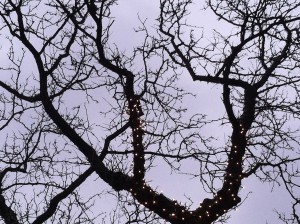Here in the Northern Hemisphere, it is the darkest time of year and tomorrow, December 21, the darkest night: the bleak midwinter. The sun reaches its southernmost point in the sky and then begins the journey north again. For a couple of days, the sun appears to be still, which is where the word solstice comes in (the Latin sol stetit, “sun stands still”). It is our own planet, of course, that is doing the shifting north and south, creating our seasons, but as we watch the sun rise and set lower and lower in the sky with each passing day, it is easy to imagine the sun as journeyer, and perhaps we all are on our individual journeys, sun and earth, you and me, constantly changing.
Now begins our real celebration of the season. We’ve watched the nights grow longer and longer through Advent, and we’ve lit more and more candles to counter the darkness. By Sunday, all four candles of the Advent wreath will be lit. It is no accident that Church elders placed the birth of Jesus Christ at the Winter Solstice. He is born, child of wonder, bringing light to the world, part of a tradition of gods from antiquity born at this darkest time of year: Sol (the unconquered sun), Apollo, Mithras.
No matter what associations you bring to the Solsticetide, the solstice night itself is worthy of marking. In this house, our celebration will be simple: last year, after Twelfth Night, we set the old Christmas tree in a quiet corner of the garden, and on this darkest night of the year, we’ll retrieve it and build a fire with that wood. It is, after all, fire that was most common in our ancestors’ celebrations of this night: fire to call down the power of the sun, to help the sun along, to be born again. Our solstice fire will be outdoors, in the sacred quiet of the back yard in the close and holy darkness, but yours could be in the hearth. If a fire is not possible, a lit candle will do nicely. Something good to drink is appropriate: a spicy dark Christmas ale, perhaps. Splurge a little; this night comes but once a year. We suggest you seek a strong ale in a tall bottle sealed with a cork. Our favorites this time of year include St. Bernardus Christmas Ale, spicy with cloves, brewed in the Trappist tradition in Belgium, and Baladin Nora, an Italian brew spiced with ginger, myrrh, and orange peel. The corked Nora bottle is sealed in wax, while twisted wire holds down the cork of the St. Bernardus bottle. Either choice will bring ceremony to the night.
You may find that in these hectic days that lead up to Christmas, in our frenetic preparations for one important day, it may be the quiet and peaceful ceremonies, like this one, that bring you the most joy and meaning. Please keep in mind that that one special day is just a beginning to what can be a really special season of twelve days. The Book of Days, certainly, will cover those days as they come. If you’ve ever felt disappointed and let down once Christmas Day has passed, we are here to help you overcome that and find meaning in each day through the 6th of January and beyond.
And so Winter begins by the almanac. By traditional reckoning of time, however, winter has been with us since Hollantide, which is why you hear so many traditional carols refer to this time as midwinter, for it truly is. From now through to the next solstice, in June, light will be increasing with each day. Now we begin to come out of winter’s dark grip. It will be a slow and gradual process, but such is the nature of the seasons.
On this darkest of nights, we salute you, we bid you peace. The bleak midwinter gathers us up in its cloak, but light is returning. Welcome Yule!
Image: Winter in La Grange, Illinois.

Thank you for these gentle words,
and thank you for their kindness.
Thank you for remembering,
the time & ties that bind us.
BEAUTIFUL, as always!
Have a very Merry Christmas and a Happy New Year!